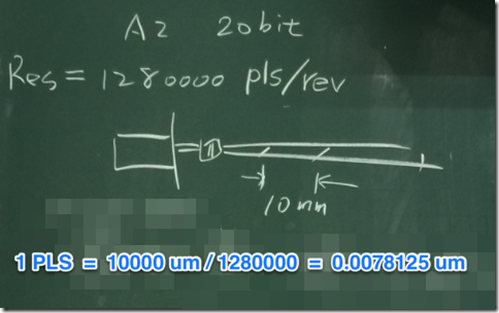The PLS unit is based on the resolution of the encoder. Take Delta A2 servo as an example. Although the resolution of the encoder is 17 bits/rev or 20 bits/rev, the PLS units are all set to 1280000 PLS/rev, which cannot be changed by the user. That is, when the electronic gear ratio is set to 1:1, the driver must receive 1280000 pulses then the motor will make one revolution.Due to the high resolution, the PLS unit is suitable for inner motor control of servo drives. However, in the motion control system, an absolute coordinate system must be established. If PLS is used as the position unit, neither the command nor the feedback is suitable, the reason is as follows :

- The displacement of the PLS unit corresponding to the mechanical end is usually not an integer metric unit and is not easily observed. In the above figure, for example, a servo is connected to a ball screw via a coupling. The resolution of the encoder is 1280000 PLS/per revolution, and the pitch of the screw is 10 mm. The length corresponding to each PLS is 0.0078125 um, which is not an integer. So it is not convenient to use.
- A control system usually contains more than one motor. Because the mechanical structures connected to each motor are different, even if the model number is the same, the corresponding mechanical displacement of each motor revolution is different, resulting in different PLS unit for each axis. This is extremely troublesome for multi-axis path planning !
- In order to improve the motor control performance, the resolution of the encoder is getting higher and higher, but the width of the position counter is still only 32 bits. Using the PLS unit will make the position counter easily overflow. For example, an encoder resolution is 23 bit/rev. If the initial position is 0, only 256 revolutions [Note 1] are required to overflow the position counter. In applications that do not allow overflow (eg absolute positioning) the travel of the machine may be long and there is a gearbox installed, it is impractical to limit the motor rotation to no more than 256 revolutions
- The traditional controller sends a physical pulse to the driver to control the servo motor. If the command unit is PLS, it will cause the pulse frequency to be too high. Take 1280000 PLS/rev as an example, to achieve 3000 rpm :
Pulse frequency = 1280000 (PLS/Rev) x 3000 ( Rev/min) / 60 (sec/min)
= 64000000 PLS/sec
= 64 MHz
It is difficult for the controller to send such a high frequency pulse. It must be scaled by the electronic gear ratio to reduce the frequency of the pulse command. The unit before the electronic gear ratio is the so-called user unit (PUU).
[Note1] Although the position counter is 32 bits, it must be deducted by 1 sign bit , The number of revolutions that make the motor not to overflow must < 2 (32-1-23)= 2 8 = 256 .